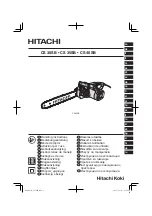
5. HEALTH AND SAFETY INFORMATION
– Close observation and inspection for dead or diseased wood and insecure limbs or branches
must be carried out prior to any cutting. Dead wood can cause unexpected reactions during a
routine felling.
– Remove any scrub or other obstructions from the area to enable a quick escape route and
ensure visibility of the chain is not impeded during cutting.
– Plan work to reduce manual lifting, i.e. lightest off cuts move furthest.
– If work is a result of wind blow, ensure no unstable trees or limbs pose any further danger.
– Never stand on anything other than the ground.
– When preparing to work on the ground, e.g. cross cutting or limbing, ensure no obstacles are
hidden or obscured from view. Contact with such an object can result in loss of footing or
kickback from the chainsaw.
Saw operation
– Do not operate the chainsaw without being completely familiar on all safety aspects, functions
and most importantly how to stop the chainsaw in an emergency.
– Do not operate the chainsaw above shoulder height.
– Regularly clear cut material as build up will create a hazard under foot.
– Never use the chainsaw if the stop switch is FAULTY or not functional.
– Prior to each use inspect the chainsaw for damage. Ensure all safety features and mechanisms
function correctly and that the cutting means is of the type and design as specified by the
manufacturer.
– Adopt a secure and balanced stance, bend knees instead of back. Hold the saw close into your
body for balance.
– Maintain a good grip with both hands on the saw. The chainsaw is solely designed for operation
of the rear handle by the right hand and the left handle on the front handle. Grip the front
handle with left thumb underneath to allow resistance in case of kickback.
– Stop the chainsaw before setting it aside.
– Only begin cutting with throttle at maximum.
– Kickback occurs when the chainsaw is stopped suddenly resulting in the tip or the guide bar
being violently thrown up towards the operator’s head/face. Correct stance and knowledge of
the operating procedure can greatly reduce that risk.
– Operate the chain brake before moving with the saw. If moving more than a short distance, stop
the saw and refit the bar guard.
–
WARNING:
during and after use, take care not to touch the hot engine parts, in particular the
exhaust muffler.
– Do not attempt to use the chainsaw if tired, ill or under the influence of alcohol or other drugs.
- 7 -
10. MAINTENANCE
- 26 -
FIG. 33
FIG. 34
– Lift the filter
from the machine. Blow any loose
dirt from inside, outwards. If dirt is hard to remove,
wash using hot soapy water. Ensure filter is fully dry
before refitting.
– Replace the filter if damaged (deformed or cracked).
10.4 FUEL FILTER - FIG. 34
– The fuel filter
should be replaced annually.
– To change the fuel filter, unscrew and remove the
fuel tank cap. Using a pair of long nose pliers, gently
pull the filter from the fuel tank. Carefully remove the
filter from the line and refit new filter.
– Use only a genuine replacement filter.








































